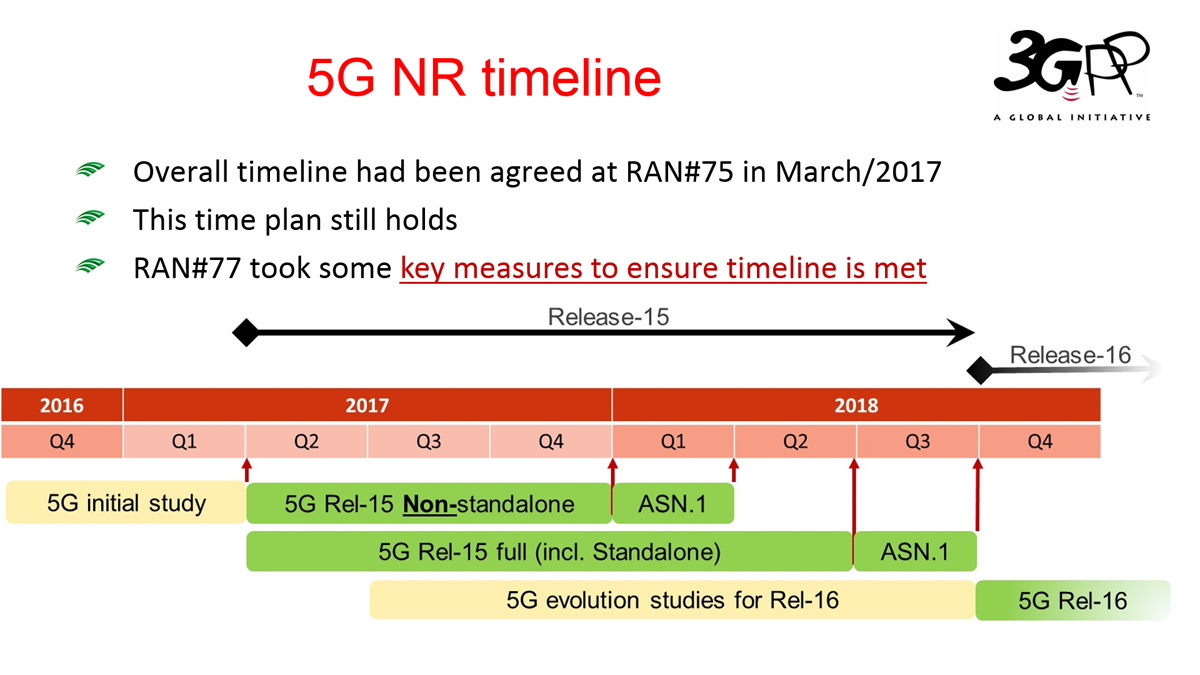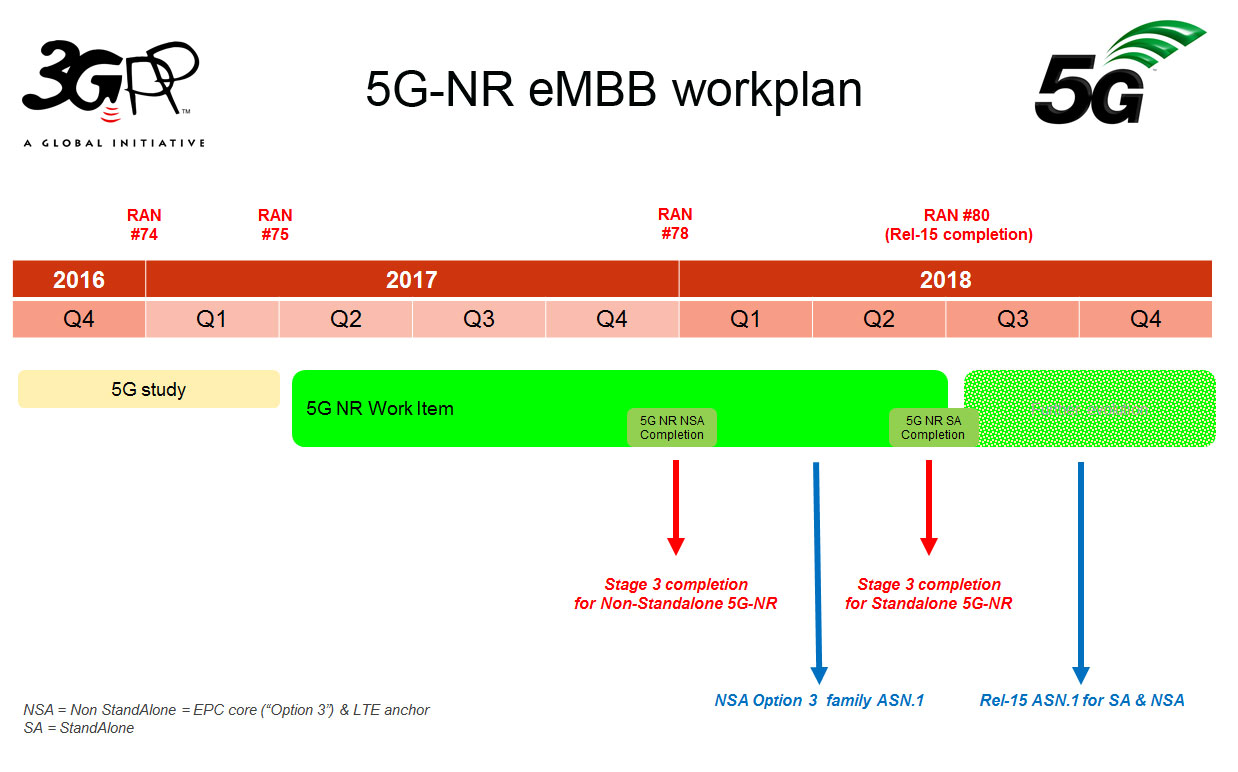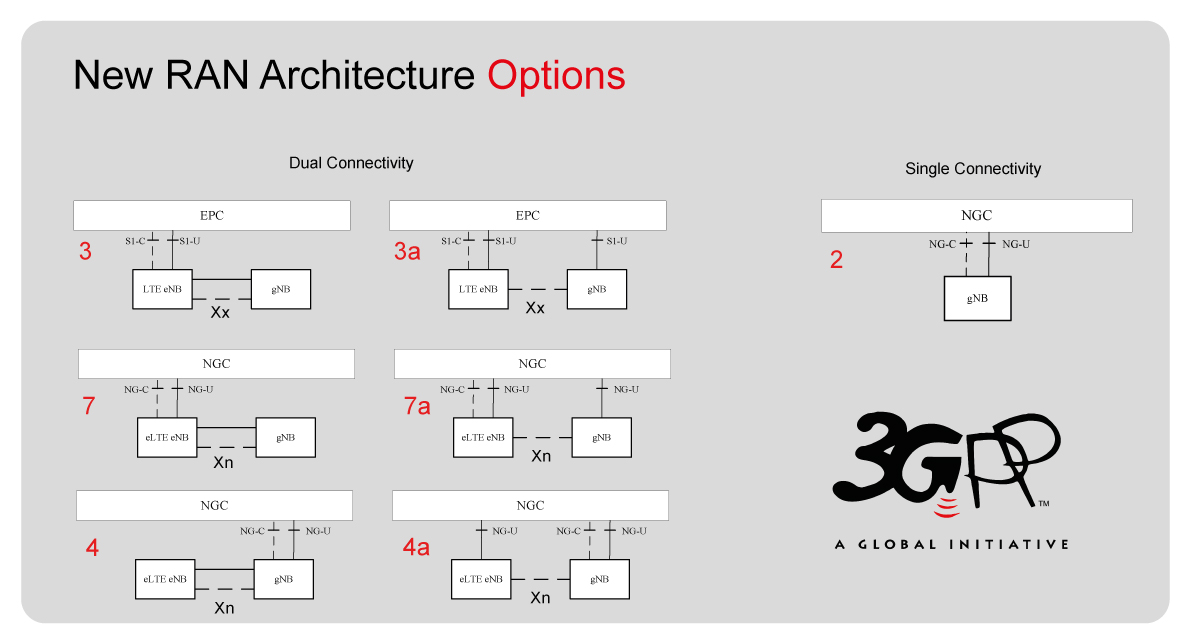Telecom: 5G New Radio (5GNR)
This article introduce the 5G New Radio (5GNR).
Overview
Refer to the following materials for 5G NR introduction:
- What is 5G NR?
- Qualcomm: Making 5G NR a reality
- Qualcomm: Making 5G NR a Commercial Reality
- Qualcomm: 5G Waveform & Multiple Access Techniques
- 5G Air Interface System Design Principles
- 5G NR standards in 3GPP
- Wireless Access and Systems Technologies for Next Generation Customers
- 5G in China: Outlook and regional comparisons
- The Next Generation of Wireless: 5G Leadership in the U.S.
- 5G New Radio (NR): Standard and Technology
- 5G and Next Generation Wireless: Implications for Policy and Competition
- Evolution of Mobile Wireless Communication Networks
- Index Modulation Techniques for Next-Generation Wireless Networks
Timeline
At 3GPP RAN Plenary meeting from March 6th to 9th on 2017, 3GPP agreed to a work plan proposal RP-170741 for the first 3GPP 5G New Radio (NR) specification that will be part of Release 15 - the global 5G standard. As part of this work plan, Qualcomm and fellow mobile industry leaders including AT&T, NTT DOCOMO, SK Telecom, Vodafone, Ericsson, and others, led a coalition of companies that committed to accelerate the 5G NR schedule by introducing an intermediate milestone for an early completion of a variant called Non-Standalone (NSA) 5G NR. This intermediate milestone will enable 3GPP-based large-scale trials and deployments as early as 2019 (more on this later).
What do Non-Standalone and Standalone actually mean?
-
Non-Standalone (NSA) 5G NR will utilize the existing LTE radio and core network as an anchor for mobility management and coverage while adding a new 5G carrier. This is the configuration that will be the target of early 2019 deployments (in 3GPP terminology, this is NSA 5G NR deployment scenario Option 3, refer to TR 38.801-e00 chapter 7.2 5G Architecture Options).
-
Standalone (SA) 5G NR implies full user and control plane capability for 5G NR, utilizing the new 5G core network architecture also being done in 3GPP (in 3GPP terminology, this is NSA 5G NR deployment scenario Option 2, Option 4/4A, Option 5 and Option 7/7A, refer to TR 38.801-e00 chapter 7.2 5G Architecture Options).
The following figures show the 3GPP Rel 15 5G NR timeline and 5G NR eMBB workplan:


Standards
ITU Recommendations
Refer to IMT-2020 (5G) for Timeline of IMT-2020, 5G Usage Scenarios and ITU-R Recommendations/Reports.
3GPP Specifications
5G NR related 3GPP Technical Specifications (TS) and Technical Reports (TR) are:
- RWS-150073 Chairman’s summary regarding 3GPP TSG RAN workshop on 5G
- SP-150149 5G timeline in 3GPP
- RP-150781 Study on channel model for frequency spectrum above 6 GHz
- RP-151606 Study on channel model for frequency spectrum above 6 GHz
- RP-150813 Study on Scenarios and Requirements for Next Generation Access Technologies
- RP-151278 Next generation new radio access
- RP-151551 Study on Next Generation New Radio Access Technology
- RP-160671 Study on NR New Radio Access Technology
- RP-161266 5G architecture options - full set
- RP-170741 Way Forward on the overall 5G-NR eMBB workplan
- TR 38.913 Study on scenarios and requirements for next generation access technologies
- TR 38.801 Study on New Radio Access Technology - Radio Access Architecture and Interfaces
- TR 38.802 Study on New Radio Access Technology - Physical Layer Aspects
- TR 38.803 Study on New Radio Access Technology - Radio Frequency (RF) and co-existence aspects
-
TR 38.804 Study on New Radio Access Technology - Radio Interface Protocol Aspects
- TS 23.501-f00 System Architecture for the 5G System; Stage 2
- TS 23.502-f00 Procedures for the 5G System; Stage 2
- TS 23.503-f00 Policy and Charging Control Framework for the 5G System; Stage 2
Requirements
Refer to 5G Usage Scenarios for the three 5G usage scenarios defined by ITU-R.
Network Architecture
According to TR 38.801-e00 chapter 7.1 New RAN Architecture, the new RAN architecture is illustrated in the figure:

The System architecture milestone of 5G Phase 1 is achieved (local pdf) offers a brief introduction to the 5G system architecture, highlighting some of its main characteristics. The complete description is provided by the delivered specifications TS 23.501, TS 23.502 and TS 23.503.
The New RAN architecture options are shown in below figure:

Protocol Architecture
RF Performance
Refer to RF Performance.
References
- 3GPP
- ShareTechnote
- ShareTechnote Index
- ShareTechnote > 5G/NR on ShareTechnote
- ShareTechnote > 4G to 5G Migration/Evolution
- 3G LTE Info
- SDX Central
- Qualcomm 5G
- 3GPP agrees on plan to accelerate 5G NR for 2019 deployments (local pdf)
- Demystifying 3GPP - An insider’s perspective to how 4G and 5G standards get created (local pdf)
- First 5G NR Specs Approved
- NR frequency band